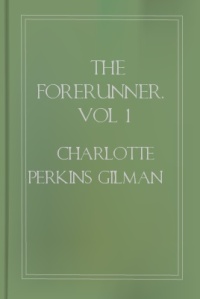ONE HUNDRED YEARS AGO, the American writer, lecturer, and feminist social reformer, Charlotte Perkins Gilman (1860-1935) began publishing a monthly journal called, The Forerunner. Written entirely by herself, she wrote on a range of topics that revolved around a central theme–social and human development was hampered by sexism and only when women were perceived and treated as human beings would we make progress as a species.

I first became aware of Charlotte Perkins Gilman while browsing the Minneapolis Public Library as a student in the 1970’s. I happened upon a reference to Gilman’s utopian novel, Herland, which depicts an all-female world where men are unnecessary, even for reproduction. I was startled to uncover a writer with such radical ideas. I read several of her other works with great interest. Reading about the life of this courageous reformer propelled my interest in American history and broadened my understanding of women’s struggle.
Gilman was a prolific writer and a single mother who tried many strategies throughout her life to earn her own living when options were limited. She wrote on many topics illuminating how women’s practical, economic and social conditions might change for the better. She traveled frequently as an invited lecturer speaking to audiences at women’s clubs, town halls, and churches.
Gilman offered perspectives on major issues of gender with which we still grapple; the origins of women’s subjugation, the struggle to achieve both autonomy and intimacy in human relationships; and new strategies for rearing and educating future generations by creating a humane and nurturing environment.
The more she developed her ideas the less she was able to sell her stories to publishers. She was advised by author and editor Theodore Dreiser “to consider more what the editors want” at which point, Gilman resolved she must publish her own writings.
The Forerunner, written, edited and published by Charlotte Perkins Gilman, was in print from 1909 to 1916 and featured short fiction, serialized novels, essays, articles, book reviews, poems and a personal advice column. Indeed, some of the published works of this prolific author; both fiction and non-fiction were originally serialized in The Forerunner. She reveals the mission for her journal with the poem “Then This” which appeared in the premier issue in November 1909.
Then This
The news-stands bloom with magazines,
–They flame, they blaze indeed;
So bright the cover-colors glow,
So clear the startling stories show,
So vivid their pictorial scenes,
–That he who runs may read.Then This: It strives in prose and verse,
–Thought, fancy, fact and fun,
To tell the things we ought to know,
To point the way we ought to go,
So audibly to bless and curse,
–That he who reads may run.
She cared about the precarious conditions for women and children and often drew attention to the connection between human society and nature. A list titled, “Reasonable Resolutions” was published in January 1910. Here, Gilman wrote:
Let us collectively resolve:
That we will stop wasting our soil and our forests and our labor!
That we will stop poisoning and clogging our rivers and harbors.
That we will stop building combustible houses
That we will now–this year–begin in good earnest to prevent all preventable diseases.
That we will do our duty by our children and young people, as a wise Society should, and cut off the crop of criminals by not making them.
The Forerunner sold for ten cents and one dollar for a year’s subscription. At its peak the magazine had nearly 1,500 subscribers from the United States and from Europe, India, and Australia. After seven years, the cost to continue publishing became prohibitive for Gilman, and the magazine was discontinued at the end of 1916.

The Forerunner
Recently, I obtained the full text download of volume one of The Forerunner from Project Gutenberg, one of many public access collections of eBooks available today online as part of the World Public Library. Again, I am enthralled by literary discovery.
Feminist researchers in the 1970’s rescued the works of Charlotte Perkins Gilman and republished many of her most important contributions. Today’s scholars have more access to original published works, but the challenge continues to protect our print and digital collections and preserve the full breadth of our cultural heritage.
It takes the sustained efforts of many dedicated librarians, archivists, historians and publishers to preserve the past and future works in our digital collections. In this movement to digitize and preserve the fragile and rare, as well as the well-documented and commercial works we hedge our bets against the calamities such as fire and neglect that have plagued librarians for centuries.
I have learned a great deal from history and specifically from Gilman’s determination to publish her ideas and seek long term support for the societal changes she thought necessary for women’s economic freedom.
I am grateful to the efforts of many who consider the critical strategies necessary to preserve historical documents. Forward thinking organizations including the Library of Congress, and the Internet Archive, work to address the tremendous challenges of building a digital library with public access to the world’s knowledge.
Yet, I am troubled when considering the question of how fragile human culture is. What will survive in our digital age of hyper-publishing on devises destined to be obsolete? Will the essential voices of today rise above the clutter of the ephemeral cloud? Will we inspire social reformers in another hundred years with tales of brave actions and perspectives that offer new hope?
Citations:
Golden, Catherine, Joanna S. Zangrando, “The Mixed Legacy of Charlotte Perkins Gilman”
Knight, Denise. “The Forerunner”. The Literary Encyclopedia. 8 January 2001.
Lane, Ann, “To Herland and Beyond”
You must be logged in to post a comment.